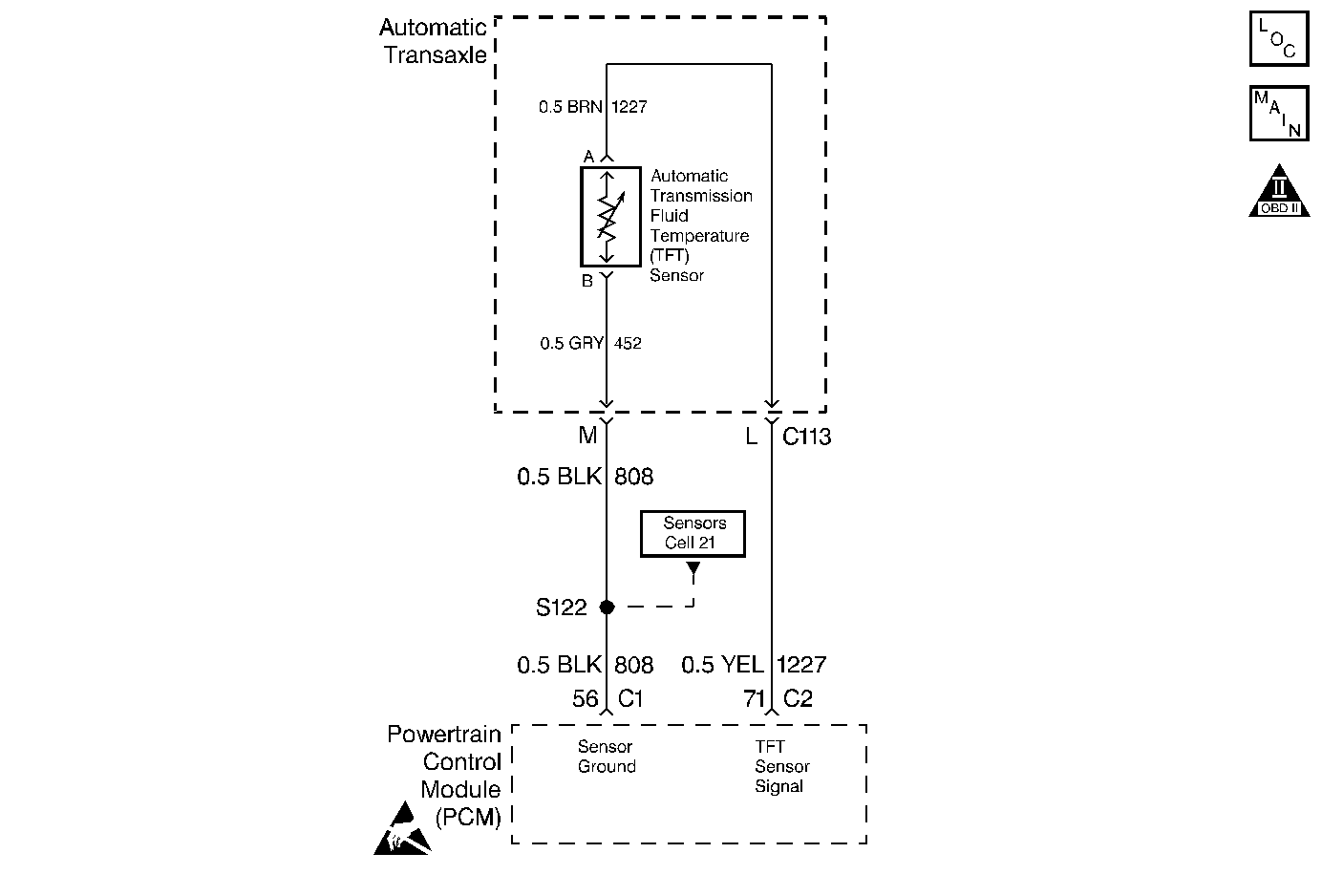
Circuit Description
The Automatic Transmission Fluid Temperature (TFT) sensor is a negative coefficient thermistor whose resistance value changes based on temperature. The PCM provides a 5 volt reference to the sensor on circuit 1227. A low fluid temperature or open circuits 1227 or 452 results in high signal voltage. The TFT operating range is -40 to +151°C (-40 to +304°F).
If the PCM detects a continuous open or a short to power on the TFT sensor circuit, then DTC P0713 sets. DTC P0713 is a Type D DTC.
Conditions for Setting the DTC
| • | The system voltage is 10-16 volts. |
| • | The ignition is ON. |
| • | The PCM detects a TFT sensor voltage of 4.92 volts or less for 7 minutes. |
Action Taken When the DTC Sets
| • | The PCM does not turn on the Malfunction Indicator Lamp (MIL). |
| • | The PCM disables shift adapts. |
| • | If the Engine Run Time is less than 3 minutes and: |
| - | Intake Air Temperature (IAT) DTC P0112, P0113, P1111, or P1112 is set, then the default Automatic Transmission Fluid Temperature (TFT) is 0°C (32°F). |
| - | No IAT DTC is set, then the default TFT is set to the IAT saved at start up. |
| • | If the engine run time is greater than 3 minutes, and an Engine Coolant Temperature (ECT) DTC P0117, P0118, P1114, or P1115 is set, then the default TFT is 131°C (268°F). |
| • | If the engine run time is greater than 3 minutes, no ECT DTC is set and: |
| - | The ECT is less than 45°C (113°F), then the default TFT is 12°C (54°F). |
| - | The ECT is greater than 115°C (239°F), then the default TFT is 131°C (268°F). |
| - | The ECT is 45-115°C (113-239°F) and: |
| • | The IAT DTC P0112, P0113, P1111, or P1112 is set, then the default TFT is set to equal the ECT. |
| • | The IAT at start up is less than 0°C (32°F), then the default TFT is set to ECT minus 10°C (18°F). |
| • | The IAT at start up is greater than 28°C (82°F), then the default TFT is set to ECT plus 10°C (18°F). |
| • | The IAT at start up is 0-28°C (32-82°F), then the default TFT is set to equal ECT. |
Conditions for Clearing the DTC
| • | A scan tool can clear the DTC from the PCM history. The PCM clears the DTC from the PCM history if the vehicle completes 40 warm-up cycles without a failure reported. |
| • | The PCM cancels the DTC default actions when the fault no longer exists and the ignition is OFF long enough in order to power down the PCM. |
Diagnostic Aids
| • | Inspect the wiring for poor electrical connections at the PCM. Inspect the wiring for poor electrical connections at the transmission 20-way connector. Inspect the wiring for poor electrical connections at the Automatic Transmission Fluid Temperature sensor connector. Look for the following problems: |
| - | A bent terminal |
| - | A backed out terminal |
| - | A damaged terminal |
| - | Poor terminal tension |
| • | When diagnosing for an intermittent open, massage the wiring harness while watching the test equipment for a change. |
| • | Test the TFT sensor at various temperature levels to evaluate the possibility of a skewed (mis-scaled) sensor. Refer to Temperature vs Resistance . |
Test Description
The numbers below refer to the step numbers on the diagnostic table.
-
If the display does not indicate an Automatic Transmission Fluid Temperature Sensor voltage greater than 4.920 volts, inspect the connectors and the terminal for intermittent problems.
-
Important: After 10 seconds, the scan tool will display a default temperature.
This step isolates the Automatic Transmission Wiring Harness by using a J 36169-A Fused Jumper Wire from terminal M to the transmission case. Inspect engine wiring harness circuit 1227 and circuit 452 for an open. Use the J 35616-A Connector Test Adapter Kit, so as not to damage the terminals.
Step | Action | Value(s) | Yes | No |
|---|---|---|---|---|
1 | Was the Powertrain On-Board Diagnostic (OBD) System Check performed? | -- | ||
2 | Has the transmission fluid checking procedure been performed? | -- | Go to Transmission Fluid Check | |
Important: Before clearing the DTCs, use the scan tool in order to record the Failure Records for reference. The Clear Info function will erase the data. Does the scan tool display an Automatic Transmission Fluid Temperature voltage greater than the specified value? | 4.920 volts | Go to Diagnostic Aids | ||
Does the scan tool display an Automatic Transmission Fluid Temperature voltage greater than the specified value? | 4.920 volts | |||
5 | Inspect circuit 1227 of the engine wiring harness for an open. Refer to Troubleshooting Procedures, Section 8. Did you find and correct the problem? | -- | ||
6 | Inspect circuit 452 of the engine wiring harness for an open. Refer to Troubleshooting Procedures, Section 8. Did you find and correct the problem? | -- | ||
7 |
Refer to Troubleshooting Procedures, Section 8. Did you find and correct the problem? | -- | ||
8 | Replace the Automatic Transmission Fluid Temperature Sensor. Refer to Solenoids and Wiring Harness, in On-Vehicle Service. Is the replacement complete? | -- | -- | |
9 | Replace the PCM. Refer to Powertrain Control Module Replacement/Programming , Section 6. Is the replacement complete? | -- | -- | |
10 | In order to verify your repair, perform the following procedure:
Has the test run and passed? | -- | System OK |
